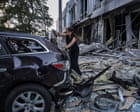
In recent developments, the path to potential peace in Ukraine sees renewed hope as both Ukrainian and Russian authorities have agreed to meet for negotiations in Istanbul. However, this positive stride is juxtaposed with ongoing conflict, as a series of drone strikes were launched overnight, leaving at least a dozen people injured. These events unfold against a backdrop of complex dynamics, demonstrating both the challenges and opportunities that lie ahead.
The negotiations, scheduled for this Wednesday, aim to address the prolonged tensions and bring about a cessation of hostilities. It is a crucial step forward, marking a moment where dialogue takes precedence, offering a pathway to resolving issues through peaceful means. The international community watches on, hopeful that these discussions may lead to a reduction in the violence that has plagued the region.
Despite the anticipation of the peace talks, the reality on the ground remains fraught with danger. The recent drone attacks underscore the ongoing volatility. Russian armed forces executed 42 drone strikes targeting Ukrainian territories, inflicting damage and causing injury to civilians. This stark contrast of violent conflict amid diplomatic efforts poses significant challenges to peace.
In an unsettling revelation, investigative reports have surfaced, highlighting the recruitment of Russian youth in military technology development. This initiative sees children engaging in ostensibly benign video game competitions, only to be transitioned into roles supporting military efforts, particularly in the development and testing of drones. This involves not only militarizing education but also blurring lines as young talent is directed towards defense projects. These practices uncover a systematic approach within Russia, revealing the extent of youth involvement in military operations.
Education in Russia has increasingly taken on a patriotic and militarized tone, with some educators expressing discomfort at the extent of the indoctrination. Despite personal reservations, teachers find themselves participating in these activities, often due to systemic pressures. This insight divulges the broader societal fabric, where education serves as a conduit for military involvement. As the investigation unfolds, it challenges perceptions of youth engagement in conflict, illustrating a deeply rooted integration into the wartime apparatus.
Amid these revelations, the upcoming peace talks stand as a beacon of hope. They offer a platform for potentially de-escalating the conflict and paving the way towards a peaceful resolution. The prospect of negotiations brings a breath of fresh air to a region long burdened by aggression. As leaders from both sides prepare for discussions, the international community extends its hopes that these efforts will culminate in enduring peace.
In conclusion, the situation in Ukraine remains intricate, where steps towards peace coexist with ongoing conflict. The duality of negotiation efforts and drone strikes reflects both the complexity and urgency of achieving resolution. It is a poignant reminder of the importance of dialogue in resolving such prolonged conflicts and restoring stability to the region.
Source: {link}
